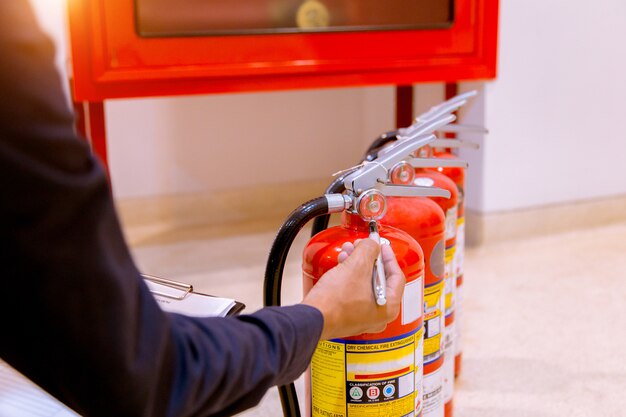Fire, a formidable force that can devastate within moments, poses a constant threat to both property and lives. In the face of this ever-present danger, having the right tools becomes paramount. Fire extinguishers, those seemingly simple red cylinders, stand as silent sentinels, ready to spring into action when needed. In this comprehensive guide, we will explore the critical importance of having fire extinguishers nearby, understanding their types, choosing the right ones for your needs, and how to conveniently acquire fire extinguisher service near me.
I. Understanding the Importance of Fire Extinguishers:
-
Immediate Response:
- Fire extinguishers serve as the first line of defense against small fires, providing individuals with the means to control and contain a fire before it escalates.
-
Versatility:
- These devices are versatile, capable of tackling different types of fires. Understanding the various fire classes and the appropriate extinguisher for each is crucial for effective fire suppression.
-
Preventing Escalation:
- The rapid use of a fire extinguisher can prevent a small fire from turning into a catastrophic event, minimizing damage and potential loss.
II. Types of Fire Extinguishers:
-
Water Extinguishers (Class A):
- Suitable for fires involving ordinary combustibles like wood and paper.
- Not suitable for flammable liquids or electrical fires.
-
CO2 Extinguishers (Class B, C):
- Effective for flammable liquid and electrical fires.
- Leaves no residue, making them ideal for sensitive electronic equipment.
-
Dry Chemical Extinguishers (Class A, B, C):
- Versatile and effective for various fire types.
- Comes in different variations, such as ABC or BC, designed for specific fire classes.
-
Foam Extinguishers (Class A, B):
- Effective for flammable liquid fires.
- Forms a blanket over the fuel, preventing re-ignition.
-
Wet Chemical Extinguishers (Class K):
- Specifically designed for kitchen fires involving cooking oils and fats.
- Cools and emulsifies the burning oils.
III. Choosing the Right Fire Extinguisher for Your Needs:
-
Assessing Fire Risks:
- Identify potential fire risks in your home or business. Different environments pose different fire hazards, and understanding these risks helps in selecting the right extinguisher types.
-
Understanding Fire Classes:
- Familiarize yourself with the fire classes (A, B, C, D, K) and choose extinguishers that cover the specific fire risks in your location.
-
Consideration of Additional Features:
- Some extinguishers come with additional features such as pressure indicators, gauge testing, and ergonomic design. Consider these features based on your preferences and ease of use.
-
Placement and Accessibility:
- Ensure that the chosen extinguishers are easily accessible in case of an emergency. Proper placement in strategic locations enhances their effectiveness.
IV. Finding Fire Extinguishers Near You:
-
Local Hardware Stores:
- Many hardware stores and home improvement centers stock a variety of fire extinguishers. A visit to your local store can provide you with options and advice from knowledgeable staff.
-
Specialized Fire Safety Retailers:
- Some retailers specialize in fire safety equipment. These stores often have a broader selection of extinguishers and knowledgeable staff to guide you in making the right choice.
-
Online Retailers:
- Explore online platforms that offer a convenient way to browse and purchase fire extinguishers from the comfort of your home. Ensure the retailer complies with safety standards and regulations.
-
Fire Safety Companies:
- Local fire safety companies may offer not only a variety of extinguishers but also inspection and maintenance services. Establishing a relationship with such companies ensures ongoing support for your fire safety needs.
-
Local Fire Departments:
- Fire departments sometimes conduct community programs that include the sale of fire safety equipment. Contact your local fire department to inquire about such initiatives.
V. Installation and Maintenance:
-
Proper Installation:
- Follow guidelines for installing fire extinguishers at optimal locations. Consider placing them near exits, kitchens, and areas with a higher risk of fire.
-
Regular Inspections:
- Schedule regular inspections to ensure that the extinguishers are in proper working condition. This includes checking pressure levels, seals, and accessibility.
-
Training and Awareness:
- Educate household members or employees on the location and proper use of fire extinguishers. Conduct drills to enhance preparedness.
-
Professional Maintenance Services:
- Consider engaging professional maintenance services from certified providers. They can ensure that your extinguishers meet safety standards and are ready for use.
Conclusion:
In conclusion, obtaining fire extinguishers near you is not just a safety measure; it's a proactive step toward protecting your property and the lives of those around you. Understanding the types of extinguishers, choosing the right ones for your specific needs, and ensuring their proper installation and maintenance are crucial aspects of fire safety. By taking these steps, you contribute to creating a safer environment, ready to face the unexpected and safeguard what matters most. Remember, the investment in fire safety is an investment in ongoing peace of mind.


No comments yet